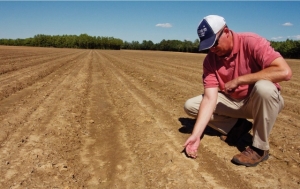Some farmers hit hard by flooding, county spared overall
By Steve Herring
Published in News on May 9, 2017 8:04 AM

News-Argus/STEVE HERRING
Wayne County Extension Service Director Kevin Johnson looks for signs that this barren field off Ferry Bridge Road was once covered in young tobacco plants. The plants were destroyed by the recent flooding.
Kevin Johnson kneels in a barren field off Ferry Bridge Road.
Just weeks ago, it was green with young tobacco plants.
But that was before heavy rains sent the Neuse River over its banks flooding the field and an adjacent field of corn.
Other than a few brown decaying plants there is little evidence remaining that anything had ever been planted there.
Johnson, director of the Wayne County Extension Service, estimates the farmer could lose $8,000 to $10,000 on the approximately 20-acre field.
Most of the corn on the adjoining field, where a low-lying area is still flooded, will probably be lost as well.
It remains to be seen what the late April, storm-fed flooding along the Neuse and Little rivers will cost farmers.
Overall the county was spared major crop damage, but for those affected it is bad, he said.
There will be the immediate cost associated with the loss of plants, but farmers will also face the cost of adjusting applications of herbicides and fertilizer that were either diluted or washed away by the rain and/or flooding, Johnson said.
On top of that is the potential for a loss in yield for plants that survived the flooding. There will be increased incidents of disease as well, Johnson said.
On average, 10,000 acres of tobacco are planted in the county. An estimated 600 acres were affected by the flooding with 25 acres lost.
"Say we had 60 percent of it set," Johnson said. "So that is 6,000 acres of tobacco, and I'd say over half of the fertilizer was lost. So they are going to have to come back with additional fertilizer.
"I mean you are looking at a significant figure when you start looking at that across the board. There is going to be some loss of weed control. There will have to be additional fertilizer out there which just adds to the total cost."
More weeds mean more management and herbicide that will need to be applied, which adds to the cost, Johnson said.
If the decision is made not to apply the herbicide, then the weeds compete with the crops which also creates added cost, he said.
"That is the thing about agriculture, it is so fluid," Johnson said. "One little thing can affect everything, and it's hard to tell."
One farmer may have more damage than another farmer just because of location even if the fields are just a short distance apart, he said.
"Farmers are at the mercy of Mother Nature," Johnson said,
Complicating efforts to calculate the loss is that plant damage that could result in reduced yields won't be known until the harvest.
It is estimated that 1,500 of the 22,000 to 30,000 acres of corn in the county was affected by the flooding.
Of those 1,500 acres, 750 acres were lost.
Johnson said to come back and replant, calculating the herbicide and fertilizer and equipment needs, could amount to a $112,500 loss.
Most of the corn lost was in the Neuse Islands area, Arrington Bridge Road, Stevens Mill Road and Ferry Bridge Road -- areas where some of the worst flooding was reported.
Some corn was affected in the Seven Springs area as well.
"They can't come back and replant with soybeans because most of them have put out pre-emergent herbicides," he said. "So you can't plant soybeans, so you are limited to planting corn back or planting something like grain sorghum."
However, grain sorghum does not have the same yield or profitability potential as corn, he said.
An estimated 300 acres of wheat were affected, but none were lost. Between 15,000 to 20,000 acres are planted in wheat.
The county's 600 acres of watermelons were affected, but none were lost.
Johnson expects the numbers to change as the season progresses.
The numbers were compiled for the USDA Farm Service Agency.
The numbers do not rise to earning the county a disaster declaration, but the total could contribute to a cumulative designation should there be more weather-related damages later in the season, Johnson said.
For now, farmers have to decide whether or not to replant, he said.
Tobacco can be set fairly quickly, but in order to qualify for crop insurance it must be planted by May 15, Johnson said.
The window for planting corn is closing as well, he said. It is nearly mid-May and the optimum time to plant corn is the first or middle of April.
"So we are already a month behind," he said. "But some of the corn will be replanted. There is no doubt, it will be replanted."
